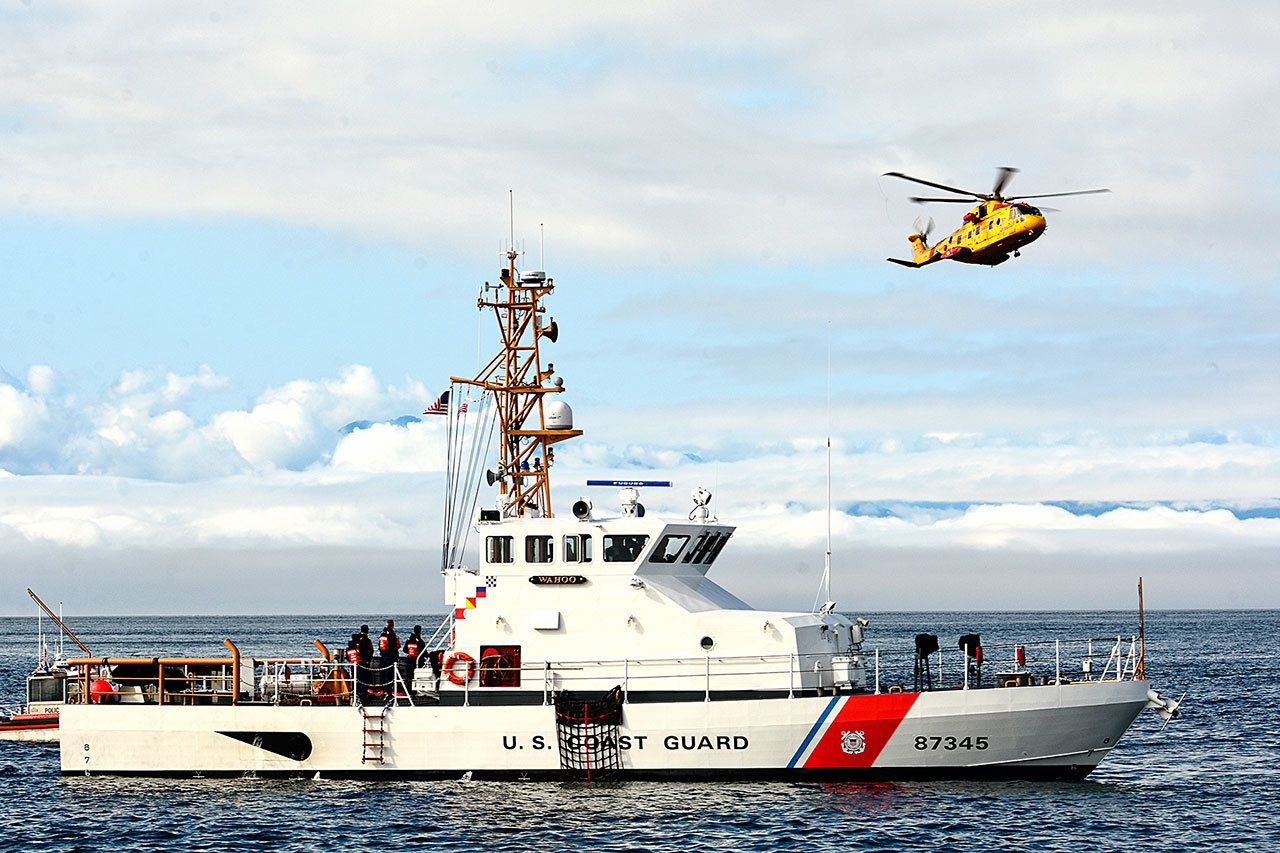PORT ANGELES — Coordinating communications among some 14 agencies was among the top priorities during the U.S. Coast Guard-led international mass-rescue drill in the Strait of Juan de Fuca on Tuesday.
The Coast Guard worked with several local agencies — including law enforcement, firefighters and paramedics — as well as Canadian first responders to simulate rescuing 60 people from the Strait after a maritime disaster about six miles north of Port Angeles.
“It’s challenging and that’s why it was our key objective,” said Lt. Erin Roberts, a contingency planner for USCG Sector Puget Sound. “In any scenario, communications is usually the first failure of an incident.”
With the number of agencies participating, it isn’t easy to coordinate communications, she said.
Among the agencies involved in the drill were the Canadian Coast Guard and Joint Rescue Coordination Center Victoria.
From this side of the border were U.S. Coast Guard, U.S. Customs and Border Protection, Clallam County Emergency Management, Clallam County Fire District No. 2, Clallam County Sheriff’s Office, Port Angeles Police Department, Port Angeles Fire Department, Olympic Medical Center, Olympic Ambulance, Lower Elwha Klallam Tribe, Arrow Marine Group, Puget Sound Pilots and American Red Cross and Clallam County Community Emergency Response Teams.
The U.S. and Canadian Coast Guards participated in the search and rescue in the Strait while others worked on triage at Coast Guard Air Station Port Angeles on Ediz Hook.
Once agencies returned to the Coast Guard station with the suits, which simulated victims, actual people with simulated injuries filled in.
First responders examined them and transported them to Olympic Medical Center in Port Angeles, where the drill continued.
“Any time that we do a drill, it just allows us to realize what could happen in an emergency,” said Julie Black, OMC’s director of support services.
Black estimated about 27 patients were transported to the hospital after the drill.
“I just think in general, our community and partner agencies worked so well together today it was just awesome to see,” she said.
Coordinating the efforts were officials with many of the agencies in the Emergency Operations Center at the Clallam County Courthouse.
For Chief Criminal Deputy Brian King, of the Clallam County Sheriff’s Office, it was an opportunity to work on communications with the Coast Guard.
What he found was the Coast Guard uses nomenclature, abbreviations and acronyms that local law enforcement don’t use regularly, which, at times, made it difficult to understand what was needed.
“One of the takeaways for us is learning some of the nomenclature that the Coast Guard has, versus what local law enforcement has,” he said. “As we were communicating, we had a lot questions of what is the asset are you requesting specifically?”
King said it was the first time his office has participated in a drill to this degree, which included both administrative and operations staff from the department.
Roberts said one of the goals of the exercise was to create a certain level of confusion for those responding, to keep the drill as realistic as possible.
“In the world of emergency management you always want to train to fail, because if you plan an exercise that goes smoothly no one learns anything,” she said.
An example, she said, is a ship having a manifest with incorrect names.
The Coast Guard identified an incident commander to coordinate the rescue efforts at the scene. Because it was a drill, the scene was much less chaotic than if it were a real incident.
One of the reasons is because the Coast Guard knew exactly who would show up to help.
“In a real event you could have double the amount of people, if not triple because there’s so many Good Samaritans that want to come out and help,” she said.
“Usually a broadcast notice to mariners is going out saying there is a mass rescue, and with that there is usually a lot of chaos ensuing.”
With the calm weather Tuesday, responders could have rescued the simulated victims within half an hour, she said. But because the goal was to give each of the responding agencies a chance to practice, the drill went into the afternoon.
“We really wanted to challenge having all of those different organizations come in and help with the rescue so they know how all that coordination and communication would go down in a real event,” she said.
The Coast Guard is required to have mass-rescue drills every three to five years, she said, though this is the first of this scale in the Port Angeles area for at least 10 years.
“[The drill] shows not just the coast guard being proactive, but every agency that participated [Tuesday] emphatically said yes, we want to practice,” Roberts said. “It shows the preparedness and the desire to be ready in the community is just at the highest level.”
________
Reporter Jesse Major can be reached at 360-452-2345, ext. 56250, or at jmajor@peninsuladailynews.com.

